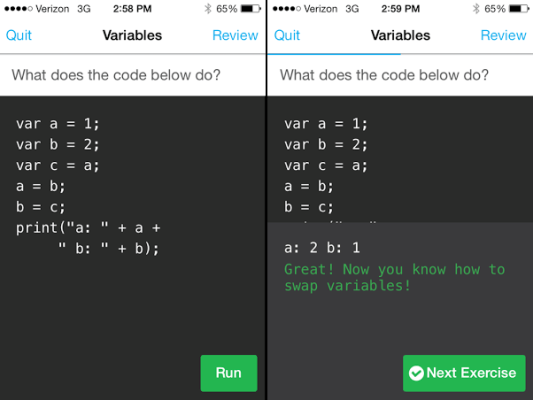Although I write a lot about apps and Internet stuff, I never really learned to code.
I threw the “really” in there to soften the blow, but the fact is, I straight up don’t know how to do it. I started learning at one point in middle school, but my high school didn’t push CS, and by college I spent all of my waking hours writing for the student newspaper or reading books written by dead white guys. So it just never happened.
But it’s on my to-do list. I swear.
Today Codecademy made its first foray into the app space and released an intro to coding course designed to take less than an hour to complete. I had a lot of laundry to do, so I figured I’d give it a shot.
The launch was timed to coincide with Computer Science Education Week, one of the goals of which is to get 10 million students in the U.S. to take an hour of coding. But the broader aim with the app was to create a version of the coursework that could be done in bite-sized portions on the go, well-suited for working professionals and busy types who want to learn a new skill.
Codecademy for iPhone will eventually be its own independent learning platform, CEO and founder Zach Sims said. Version one is very basic — it essentially shows you what coding looks like and what the most rudimentary functions are — and the team is hoping to push more content out this week.
The app is meant to be a super-easy onboarding ramp to future coding. The text feedback you get after each question is encouraging and makes you feel like you’re nailing it, which is nice motivation if you, like me, have a fragile but easily swollen ego. I finished the course just before the wash cycle on my lights ended and immediately wanted more.
The program is currently broken up into five different sections that flow from one into the next: an intro (“Getting Started”), Data Types, Variables, Comparisons, and If… Else. Each comprises a few examples and questions, making for, as Sims put it, a series of “snackable” lessons.
The learning experience has to operate under the usual constraints of mobile, specifically a smaller screen size and user intolerance for typing a lot. Whereas Codecademy’s desktop service supports learning by doing, the app holds your hand a bit more. Rather than writing their own code, users fill in brief segments of pre-written lines of code, most of which are presented as multiple-choice questions. For some sections, you just have to hit “Run” without answering a question
Some of the questions seem ridiculously easy. In the introductory section, for instance, you are asked, “Can you write a program that calculates ‘6-2’?” and all you have to do is fill in “print(6 ? 2);” with a minus sign. (The “?” there is a box that you tap for your multiple-choice options.)
“Ha-ha!” You may laugh to yourself. “Coding is for dummies! I’ll make a fortune on my app idea!”
That’s the trouble with passive learning, rather than working all the way through a problem on your own. You have to remember to pay attention.
My only issue with the half hour I spent on the app today (humblebrag) is that there weren’t any definitions provided, so you might have to Google things like “what is a string?” Just for instance. Presumably that will get ironed out as Codecademy continues to build out the mobile wing of its business.
The goal is to create a product that is platform-agnostic, Sims said, citing Duolingo as an ed-tech company that has succeeded in that regard. The restrictions on producing one’s own code are tough, so I’ll be looking forward to seeing how Codecademy negotiates that. For now, I think I’m going to sign up online.
